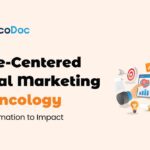Introduction: Beyond Visibility to Clinical Relevance
In modern oncology, digital marketing is no longer about simply being seen; it is about being useful. Oncologists operate in a high-stakes, time-constrained environment where every piece of information must aid clinical decision-making. Traditional digital metrics like click-through rates, impressions, and brand visibility are no longer sufficient. Pharma marketing must evolve from attention-seeking to value-generating.
This article explores how digital strategies in pharma, especially in oncology, can be reimagined to focus on trust, credibility, and clinical utility. When done right, digital campaigns have the potential to become indispensable tools for oncologists, enhancing patient outcomes while strengthening brand loyalty.
1. Provide Clinical Utility Through Digital Tools
Digital tools must go beyond showcasing product benefits. They should help oncologists make precise, confident, and informed decisions. The most effective digital assets mimic the clinical workflow. Tools that are available on demand, compatible with mobile devices, and embedded in daily decision processes are far more valuable than promotional content.
Key examples include
- Interactive treatment algorithms customized by tumor type, stage, and biomarker profile
- Clinical calculators that adjust dosage based on renal or hepatic function
- Protocol summaries for biosimilar switches
- Tumor board-ready slide decks for key clinical decision points
- Side effect management protocols tailored by drug and comorbidity
These tools allow oncologists to use brand-supported resources during patient consultations, directly contributing to their clinical responsibilities.

2. Respect Time with High-Impact Micro-Content
Today’s oncologists juggle packed schedules, administrative burdens, and emotional fatigue. They do not have time to read lengthy white papers or attend one-hour webinars. What they need is micro-content: short, specific, and high-value assets that they can consume quickly and apply immediately.
Effective micro-content includes:
- 60-second explainer videos (e.g., dose titration, treatment sequencing)
- Quick-reference PDF guides for biomarker testing or therapy combinations
- Infographic summaries comparing clinical outcomes
- Chatbots delivering recent updates from ASCO, ESMO, or NCCN
These formats are ideal for mobile-first delivery and enable learning during clinic breaks, travel, or downtime.

3. Support Patient Communication and Caregiver Needs
Oncology is not just physician-facing. It involves an entire care ecosystem, including patients, families, and support staff. Empowering oncologists to communicate effectively with patients is a key differentiator in pharma marketing. This builds trust not just in the drug but also in the brand.
Content that serves this purpose includes:
- Explainer videos for patients, in regional languages, covering drug mechanisms and treatment expectations
- Printable chemotherapy safety sheets and emotional readiness guides
- Multilingual consent forms and FAQs
- Support tools for caregivers (burnout resources, checklists, contact logs)
Oncologists can easily share these materials through QR codes, clinic apps, or messaging platforms, enabling standardized education without consuming additional consultation time.
4. Build Trust Through Transparency and Personalization
Trust is the currency of oncology marketing. Unlike other therapeutic areas, oncologists are highly analytical and skeptical of promotional content that lacks data or authenticity. Transparency must be built into every digital interaction.
Pharma brands should
- Display mechanisms of action along with adverse effects in a balanced, evidence-based format
- Cite local regulatory approvals and make compliance visible (e.g., DCGI, ICMR)
- Personalize content by tumor sub-specialty and geographic relevance
- Use Indian clinician testimonials and avoid stock photography or generic design
Authenticity goes a long way in building brand affinity. A personalized, informative video or email is far more valuable than a glossy advertisement.
5. Align Digital with Field Efforts
Digital marketing should not operate in a silo. Instead, it should empower field representatives and medical science liaisons (MSLs) by feeding them data-driven insights.
- Reps can prioritize follow-ups based on toolkit downloads or email open rates
- MSLs can address questions sourced from digital platforms in field conversations
- Regional trends in digital engagement can shape field content strategies
This integrated approach enhances brand consistency and maximizes the return on both digital and human efforts.
6. Measure What Matters: Meaningful KPIs
Clicks, impressions, and open rates are vanity metrics unless they lead to actionable engagement. Pharma marketers should focus on value-centered KPIs that reflect genuine clinical interest.
Examples of meaningful metrics:
- Tool reuse rate (how often decision aids or calculators are revisited)
- Time spent on educational modules or infographics
- Frequency of peer-sharing or patient-sharing content
- Rep meetings following digital engagement
Survey responses to “Did this help you in your clinical practice?”

Conclusion: From Promotion to Partnership
In oncology, pharma marketing must rise to the occasion. The stakes are high, and oncologists expect more than awareness campaigns. They need real-world insights, time-saving tools, and content that improves patient care. When pharma marketers commit to providing genuine value through digital channels, they earn more than attention; they earn trust and long-term engagement.
To lead in this space, brands must:
- Deliver clinically useful tools, not just information
- Respect the time and attention span of the audience
- Enable meaningful patient interactions
- Use transparency and personalization to build trust
- Align digital and field teams for consistent experiences
- Track KPIs that reflect real influence, not just exposure
In doing so, pharma companies will no longer be seen as promoters of products but as partners in cancer care.
The Oncodoc team is a group of passionate healthcare and marketing professionals dedicated to delivering accurate, engaging, and impactful content. With expertise across medical research, digital strategy, and clinical communication, the team focuses on empowering healthcare professionals and patients alike. Through evidence-based insights and innovative storytelling, Hidoc aims to bridge the gap between medicine and digital engagement, promoting wellness and informed decision-making.



